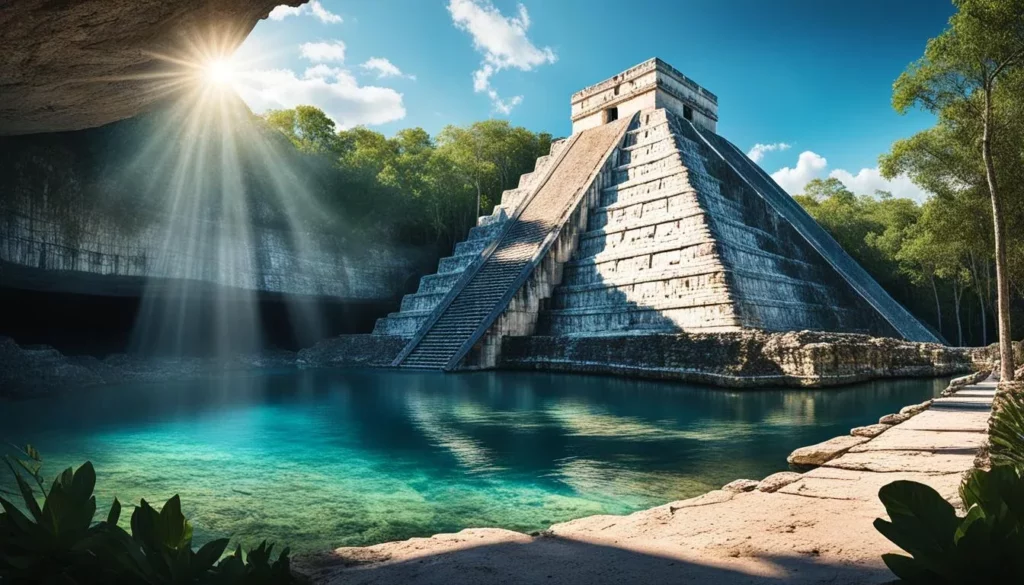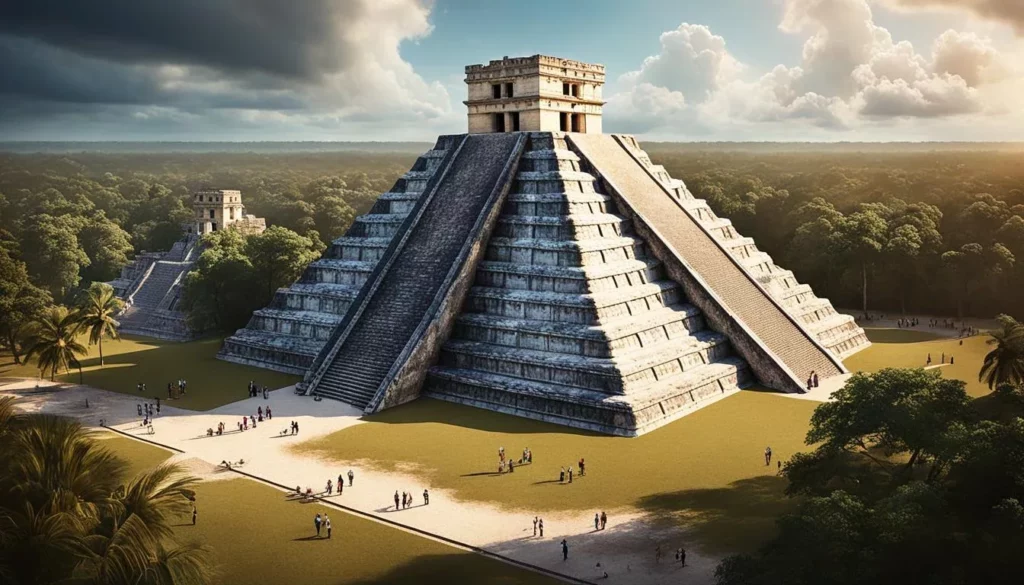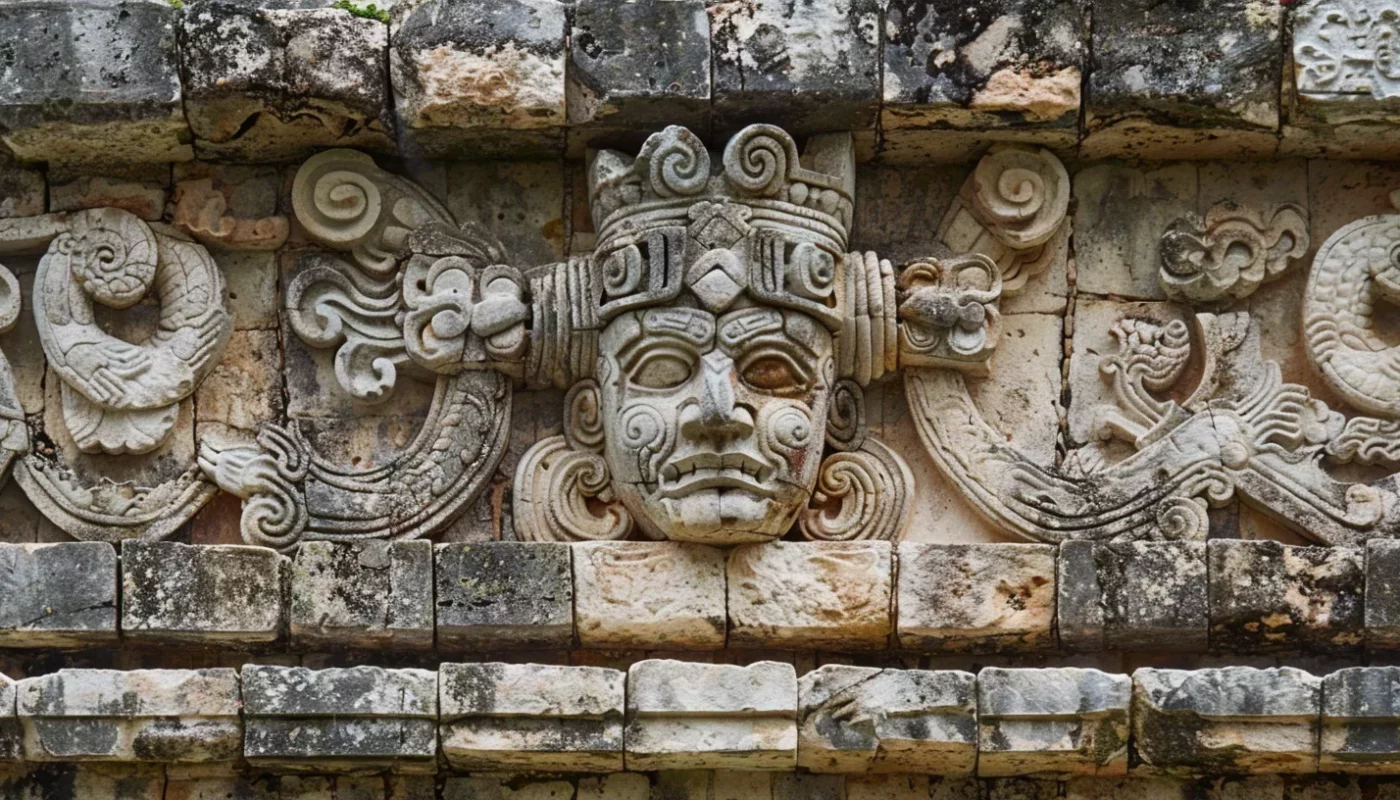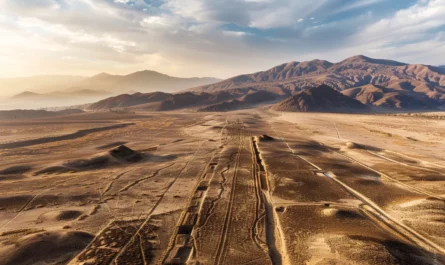Did you know Chichen Itza attracts more than 2.6 million visitors each year? It’s among the top heritage sites in Mexico. Located in the Yucatan Peninsula, it shows the Mayans’ architectural and scientific skills.
Chichen Itza is a UNESCO World Heritage Site and a New Seven Wonder of the World. It impresses visitors with its huge pyramids, detailed carvings, and rich history. Staying at Hacienda Chichen Resort gives a closer look into this Mayan wonder.
Chichen Itza is not just for history enthusiasts. It offers a glimpse into the Mayans’ advanced society. From calendars to buildings, they were ahead of their time. It’s a must-visit for anyone interested in the Yucatan or ancient history.
Keeping Chichen Itza intact is vital. Sustainable tourism helps make sure it stays open for all to see. When you visit, you help take care of this amazing place for the future.
The History of Chichen Itza
The story of Chichen Itza is truly fascinating, woven into the world of the Maya. This site is a gem on the UNESCO World Heritage list. “Chichen Itza” means “at the edge of the Itza’s well” in Mayan. “Itza” talks about a Mayan group known as “Water Magicians.” This name shows their deep bond with nature.
Origins and Name Meaning
Chichen Itza began around 600 AD, during the Mayan Early Classic Period. The name combines “chi'” (meaning “mouth” or “edge”) and “ch’e’en” (meaning “well”). It highlights how vital water was to their life and rituals.
Key Historical Periods
Chichen Itza has a rich history with several important eras. It started in the Pre-Classic Maya period with the first few temples. During the Mayan Early Classic Period, its culture and buildings became more complex.
From 415-455 AD, the Maya-Toltec cultures merged. This era brought us the Kukulkan Pyramid and the Great Ball Court. Their design features serpents, which were very special to the Mayans.
In the 10th century, Toltec conquerors led by Kukulkan, or Quetzalcoatl, arrived. They mixed their culture with the Maya’s, enriching Chichen Itza’s history even more. This mix makes it a key Mayan site today.
Chichen Itza is well preserved, thanks to ongoing efforts. It was recognized by UNESCO for its historical importance. Today’s efforts aim to keep the Mayan heritage and their architectural wonders alive for us to see.
El Castillo: The Temple of Kukulkan
El Castillo is also known as the Kukulkan Pyramid. It shows the ancient Mayans’ amazing building skills. This famous structure is a key site at Chichen Itza. It’s known for its beautiful design and deep link to astronomy.
Architectural Brilliance
The pyramid’s design is a masterpiece of Mayan architecture. It has a staircase on each of its four sides. Each staircase has 91 steps, adding up to 364 steps in total. The top platform counts as the 365th step.
This brilliant design mirrors the Mayan solar calendar. It shows the Mayans’ strong grasp of math and building skills. They built lasting monuments that still amaze us today.
Astronomical Significance
The Kukulkan Pyramid is more than just a stunning building. It’s also an important astronomical tool. At the Equinox in Chichen Itza, the pyramid creates a special shadow. This shadow makes it look like a serpent is moving down the staircase.
This event represents the feathered serpent god, Kukulkan. It highlights the Mayans’ close bond with the stars and their importance in their rituals and everyday life.
El Castillo stands as a key symbol of Chichen Itza. It brings together beauty, science, and religion in Mayan culture.
| Feature | Description |
|---|---|
| Steps | 91 steps per side, totaling 365 |
| Symbolism | Representation of Mayan solar calendar |
| Equinox Shadow Effect | Feathered serpent illusion during equinoxes |
| Architectural Style | Mesoamerican step pyramid |
The Great Ball Court
Chichen Itza has the biggest Mesoamerican ball court found, sized at 166 x 68 meters. This huge playing field shows how important the Pok-Ta-Pok game was to ancient Mayans. High walls around the court were impressively carved. They showed cultural rituals in Mayan society. The feathered serpent images stand out, showing the place’s deep meaning.
Size and Structure
The Great Ball Court’s large size tells us a lot about ancient Mayan sports. It stretches 166 meters by 68 meters. Around it, tall walls showcase stone carvings. These carvings are more than decorations; they share stories of cultural and athletic passion. Every part of this historic site highlights the Pok-Ta-Pok game. This game was crucial to the Maya culture.
The Ball Game and Cultural Importance
The Pok-Ta-Pok game was key in Mayan culture and religion. It was more than a game; it was a cultural ritual. The large court and its meaningful carvings show us the ancient Mayans’ spiritual world. We see warriors and gods in these carvings. They remind us of the game’s spiritual importance and its role in rituals and traditions.
“The Great Ball Court of Chichen Itza is not just an architectural feat; it stands as a monumental reminder of the athleticism and deep-rooted cultural rituals in Mayan society.”
- At 166 x 68 meters, it is the largest known Mesoamerican ball court.
- Prominent feathered serpent designs are etched into its walls.
- Pok-Ta-Pok was both an athletic and religious endeavor.
- Reliefs on the court walls depict the game’s sacred significance.
Conservation efforts are in place to save the Great Ball Court. They aim to keep the structure and art safe for future generations. This effort helps us appreciate ancient Mayan sports and spiritual practices.
The Sacred Cenote
The Sacred Cenote at Chichen Itza was central to Mayan religion. It was not just a natural wonder. It was seen as a portal to another world, key for their rituals and gifts to the gods.
Religious Ceremonies and Offerings
Many Mayan religious activities happened at the Chichen Itza cenote. Research in Yucatan shows it was a site for many offerings. Finds include jade, gold, and pottery, as well as signs of human sacrifices. These were meant to please the gods and keep the community safe.
Archaeological Discoveries
Yucatan’s deep archaeological work tells us much about the cenote’s past. Scientists found many artifacts and human bones, highlighting the ceremonial role of these sacred sites. The cenote’s beauty and these discoveries reveal much about Mayan beliefs and rituals.

Protecting the cenote is crucial for preserving Mayan cultural insights. Archaeologists and conservationists aim to keep this site safe. This lets us keep connecting with ancient Mayan ways.
The Temple of the Warriors
The Temple of the Warriors is a key part of the Chichen Itza temple complex. It shows us the rich history of the Mayan culture. The Carnegie Institute restored it, proving the skill of ancient Mayan builders.
This temple has Mayan warrior columns and detailed carvings. These reflect the Mayans’ fighting skills and religious passion. Chac Mool statues there hint at important ancient Mayan ceremonies.
As a major cultural heritage site, this temple shows off Maya’s architectural greatness. It keeps us connected to their traditions and beliefs. The detailed serpent sculptures mix art with spirituality.
Preserving the Chichen Itza temple complex shows how vital these sites are. Efforts to save it help ensure that the powerful Mayan warrior culture lives on. This way, it can keep inspiring and teaching us all.
Mayan Cosmology and Architecture
The design of Chichen Itza shows a deep link between its buildings and the stars. The Mayans aligned their structures with the sky, showing their vast knowledge of the universe.
Chichen Itza’s observatory, known as El Caracol, stands as a testament to the advanced astronomical knowledge of the Mayan-Toltec civilization.
El Castillo is key in showing this blend of beliefs and architecture. These buildings were not just religious spots. They also showed the Mayans’ deep beliefs by lining up with the sun and moon.
The Puuc style showcases the Mayans’ skill in both art and engineering. It features detailed stone mosaics and masks. These designs are beautiful and full of meaning.
We’re keeping these ancient wonders safe for the future. This lets people keep learning from the Mayan-Toltec culture and its lasting impact on building design.
The Observatory: El Caracol
El Caracol, known as the Maya Observatory, is a major attraction in Chichen Itza. It was built in AD 906, during the Post Classic period. This structure proves the Mayans’ deep knowledge of the stars and their astronomical achievements.
Astronomical Observations
The El Caracol structure was made to watch the skies, focusing on Venus. The Mayans saw Venus rise in the west and set in the east at different times. This pattern repeated every 225 days. By tracking this, the Mayans linked Venus cycles with solar years, showing their skill in astronomy and time-keeping.
Architectural Design
The design of El Caracol is impressive. Its round shape and strategic windows let Mayans observe key astronomical events, important for Chichen Itza’s people. The flat landscape around helped them view the sky without any blockage. This design highlights their ability to match architecture with cosmic events.
Keeping El Caracol safe is vital. Efforts to preserve it help us appreciate the Mayan understanding of astronomy. By careful management, El Caracol’s wonders can be enjoyed by many more in the future.
The Influence of Chichen Itza
Chichen Itza has deeply influenced Mayan culture through its architecture and ceremonies. Archaeological research in Mexico shows how it affected the region and ancient city-states.

The site mixes Maya and Toltec styles, showing how different cultures influenced each other. This blend of design changed ancient societies.
| Influence Type | Manifestations |
|---|---|
| Architectural | Blending of Toltec design in structures like the Temple of Warriors. |
| Ceremonial | Ritual practices observed in sacred sites like the Sacred Cenote. |
| Cultural | Integration of diverse cultural traditions reflecting broader Mesoamerican influences. |
Chichen Itza’s blend of Maya and Toltec designs show its big role in studying ancient cities. Ongoing archaeological research in Mexico keeps revealing its impact. It shows how Chichen Itza shaped Mesoamerican heritage.
Conservation Efforts
Chichen Itza is a UNESCO World Heritage site. It requires careful conservation to keep its historic value. Plans manage how visitors see the site while keeping its history safe.
Protection Mechanisms
Chichen Itza is protected by law. It’s marked as an archaeological monument. These laws help control how the site is used. They prevent harm and keep the site real.
Modern-Day Preservation
Sustainable tourism is key at Chichen Itza now. There are limits on how many visitors can come. Eco-friendly tours are offered. Education about conserving UNESCO sites is shared. Together, these steps help save the site for the future.
Conclusion
Chichen Itza is a window to the ancient Mayan legacy that captures hearts around the globe. Visitors are amazed by the grand sights like El Castillo and the Great Ball Court. These sites highlight the Maya-Toltec civilization’s rich history and culture.
Every visit deepens the appreciation for the Mayans’ architectural and scientific skills.
Chichen Itza is more than a place to visit. It’s a beacon of cultural tourism that teaches and inspires. The Sacred Cenote shows the Mayans’ religious depth. El Caracol demonstrates their knowledge of astronomy. These aspects help us understand the complexity of ancient societies.
We learn about the ingenuity and cultural growth of these ancient people through Chichen Itza.
Keeping Chichen Itza preserved is vital. There are efforts to balance tourism with the site’s care. This way, we can protect it from environmental and human harm. Thanks to these efforts, future generations will continue to discover this wonder.
By protecting Chichen Itza, we ensure it teaches future generations about our world’s archaeological marvels.




